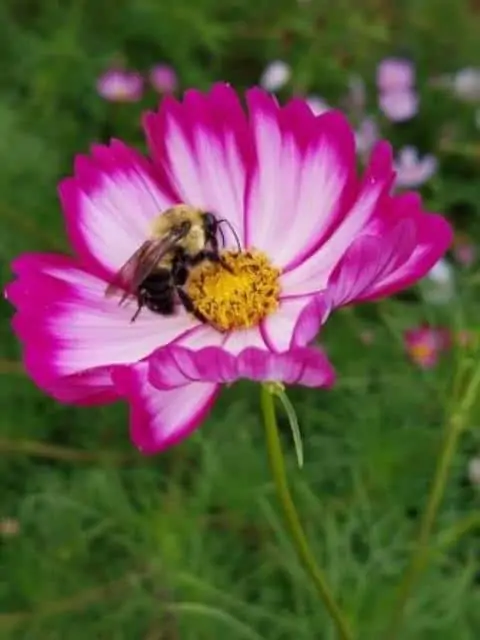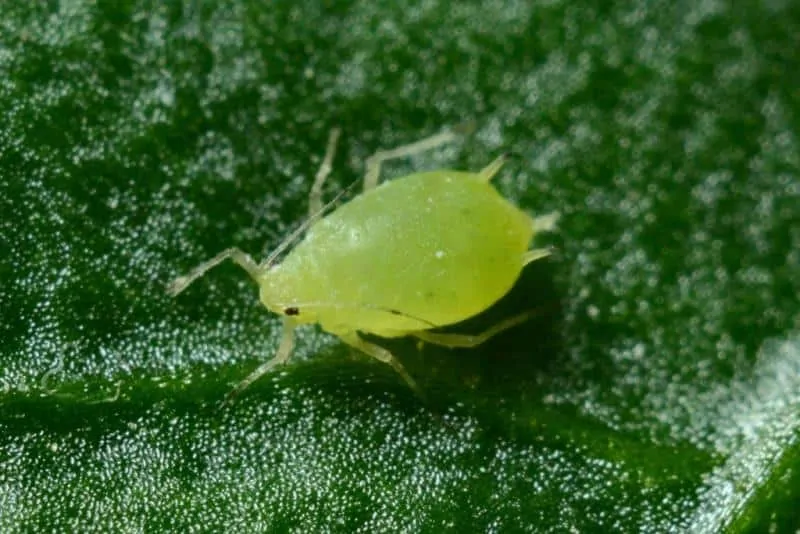In our previous post, we have learned How to grow Mexican Aster. Today we will discuss everything about Mexican Aster Pests and Diseases. Cosmos Bipinnatus is commonly called Mexican Aster or Cut Leaf flower. It is a member of the Asteraceae family along with Yellow Aster and others. It is a daisy-like flower with 7 to 20 petals arranged in spiral order. Each Mexican Aster flower can grow 2-3 inches in diameter. there are many color variants available including Pink, Red, White, Purple, and Yellow. Mexican Aster is very easy to grow and maintain. the best part is that you can grow this plant anywhere from hardiness Zone 1 through 10 or 11.
If you are a gardener then you must know that we have to face some problems occasionally in our garden. The most common yet irritating among all of those are the pests and diseases. If you ignore the pests and diseases in Mexican Aster plants then you will lose the plant in a few weeks. So we will discuss the symptoms treatments of these problems. Keep reading to Know More.

Also read: What is the Importance of Weeding?
Is Mexican Aster prone to many pests and diseases?
Just like any other Aster flower Mexican Aster also faces several pests problems. Although Mexican Aster is a fairly strong and hardy plant. It can easily sustain mild pests attacks. Only the severity can cause problems enough to threaten the plants.
Pests and diseases are so common in flowering plants. That you cannot ensure 100% security. These problems are inevitable but you can reduce their occurrence. The first thing to do in this regard is to reduce the circumstances that support pests and disease buildup.
Look ut for the Source of the problems and act accordingly.
- Lack of Sunlight.
- Crowded Growing area
- Infected Plants
- Infected Gardening Tools
- Overwatering
- Too much use of fertilizers
- Bad Climate or Soil Conditions
Every condition in this list is capable of increasing pest attacks in your Mexican Aster plants. You have to ensure that neither of these can interfere with the growth of the plants. It requires proper planning before planting the Mexican Aster in the garden. Allow the plant to properly breathe and receive full sun. Remove any infected plant to ensure the safety of others. Clean the gardening tools by rubbing Alcohol before and after each use. Don’t use too much fertilizer and avoid overwatering. You can’t control the climatic condition yet plan for the right season to grow Mexican Asters. Always use healthy god quality soil mix for Mexican Aster plants.
Common Pests that can attack Mexican Aster
Several pests can attack your Mexican Aster Plants. The most common of these are-
- Leafhoppers
- Aphids
- Spider mites
- Whitefly and black flies
- Mealybugs
- Thrips
Aphids
Aphids are transparent to light green tiny bugs that suck plant sap. They usually like to hide on the lower side of leaves away from direct sunlight. Treat these bugs with soap water and neem oil spray twice every week.

Check out: Common Pests and Diseases in Chilli Pepper Plants
Spider Mites, White Fly, and Black fly
These are also tiny bugs that feed on plant sap. Whits flies and black flies are easy to identify as they have their specific color. They are tiny yet very devastating for the plant. Spider mites are light red to brown and they can shunt the plant growth. If you ignore these bugs then the plant may stop growing and blooming further. Treat the plant with a water jet and then apply neem oil or soap spray to control these bugs. You have to apply the treatment for a minimum of 2 weeks at 2 days intervals.
Leafhopper
These bugs feed on the foliage and tender steps. they can eat new buds and deform the plant heads. Neem oil spray can distract them although you have to use Carbendazim, Copper oxychloride, or Triconazol to avoid further infestation.
Thrips
Thrips are another common pest in Mexican Aster Plants. They are tiny bugs not very easy to see and observe. They feed on the plant sap and devour the tender foliage. Shunted growth and curling of the plant head is common symptom of thrip attacks. Overwatering and too much fertilization in a closed crowded area is the main source of thrips attack. Keep the area around the plants clean and well hydrated. Also, keep the foliage dry and spray the plants with neem oil and soap solution twice every week. In severe conditions pinch off the infected head and use fungicide with all-purpose pesticides.
Mexican Aster Plant Disease and Treatment
Pest attack is usually followed by common plant diseases. Insects and pests are the main vectors of plant diseases. Although you can easily treat pest problems, the diseases are not so easy to control. Most Plant diseases are hard to identify and treat. Infected plants may have reached their fatality by the time you notice the problem. So precaution and prevention is the best option for plant diseases.
you may also like this: Ranunculus Asiaticus: Common Pests and Diseases
Common Diseases in Mexican Aster Plants
- Viral Phytoplasma or Mycoplasma
- Bacterial Wilt
- Powdery Mildew
- CanKer
- Rust
- Leaf Spot
- Root and Stem rot
Phytoplasma
Phytoplasma is the main source of many viral diseases in American Aster. It can cause rotting, shrinking, curling, or deformation for buds, and flowers. Phytoplasma formerly known as Mycoplasma is spread by a vector known as Leafhopper. We have already discussed these bugs in the previous section. you can control the spread by controlling Leafhoppers in your garden. An infected plant cannot be saved with full vitality. therefore, discard and destroy plants infected with Phytoplasma.
Bacterial Wilt
Wilting is common in Mexican Aster. It is a soil-borne disease. So treat the soil with Tricodrma, or Copper sulfate before sowing seeds. You can use organic liquid Consortity for the prevention of Bacterial wilt. Infected tools play a more role in the spread of Wilt disease in the garden. Rotate crops and plants to reduce the chances of wilting.
Powdery Mildew
White powdery disposition on the stem and foliage is easy identification of powdery mildew. They can damage the plant. The infected plant will lose its growth and eventually curl and shrink to death. keep the plant clean by washing off these problems. Let the plant dry and spray again with fungicides to avoid further infestation.
Canker and Rust
both canker and Rut are spread by soil, water, and infected tools. Therefore, proper care is necessary to avoid these problems. Dark brown patches and ring formation are common in these problems. The patches will continue to grow and the plant will die eventually. Prevention is better in these plant diseases. Infected plants can’t be cured properly. Though you can use Copper Sulphate, Copper oxychloride, Consortia, Azardactin, and other all-purpose pesticides and fungicides to control the spread.
Leaf Spot and Root rot
These diseases can have variable sources. They can occur due to severe pests attacks, bacterial infections, fungal growth, or any viral disease. The main source of these problems in the Mexican Aster plant is overwatering and deposition of water on the leaves and stems. So make a habit of regular plant care and avoid overwatering. Let the roots and foliage dry properly before the next spell. there are many solutions available for these diseases. Though simple plant care is sufficient to control and treat them.
Precautions to Avoid Pests and Diseases in Mexican Aster
There are a few steps that you can follow to reduce the chance of pests attack in Mexican aster plants. Most plant diseases are carried by one or many vectors. If you manage to stop the movement of infected vectors from one plant to another then the risk is low.
You have to take preventive measures to ensure the safety of these beautiful Mexican Aster Plants. Mexican Aster also faces problems in the form of pests and diseases. These common Pests and diseases attack a plant in search of an easy food supply or a better breeding ground. The plant only needs a little separation from the favorable condition of these pests. Without food to breeding ground fewer pests attracts towards the plant, and it becomes very easy to treat them.
Precautions to Avoid Pests and Diseases
- Rotate the plant from one location to another. Any plant including Mexican Aster growing in one location for more than 3 years can accumulate a large number of pests. These pests are specific for the Aster plants so the severity of infestation will increase day by day. Changing the location can stop the pests and disease accumulation in one area.
- Amend the soil with fungicides especially if it is prone to fungal growth. Sowing seeds or seedlings in infected soil can lead to many soil-borne diseases. The problem will continue until the plant dies. So a little care before planting Mexican Aster is better for the entire batch.
- Treat Mexican Aster seeds and seedlings with fungicide before plantation. Infected seeds may carry disease to a very long distance. You cannot detect the issue until it becomes a big problem in your garden. Simple treatment of the seeds in any contact or systemic fungicide can save the spread of the fungal infestation. You can also use liquid consortia to reduce the chances of bacterial diseases.
- Avoid splashing soil on the foliage of the plant during watering. It is the main reason for fungal and other bacterial diseases in most plants. Splashing of Water is a common vector for soil-borne diseases.
- Never water the Mexican Aster Plants from the top. Water droplets in the tiny cut leaves can attract many pests and also cause fungal infections. Spray water only in the morning time if necessary for the plant. The droplets should dry out during the day. Moist foliage in the evening or night is more prone to pests attacks.
- Use clean, sanitized gardening tools for digging and running the Mexican Aster plants. Tools are a common vector or carrier of plant diseases. Both fungal and bacterial infections can easily spread from one plant to another by an infected tool. Therefore, wash off the tools with clean water and then rub them with Alcohol. Cleaning of tools must be done after each use to ensure proper sanitation.
Special Care for Mexican Aster Plants
Mexican Aster plants require open space to grow. So plan for a growing area where these plants can get enough airflow and at least 6 to 8 hours of direct sunlight. Mexican Aster can survive in part shade but never grow in full shade under a tree.
Inadequate sunlight of airflow can lead to severe pests attacks in Mexican Aster plants. Maintain at least 2 to 3 feet gap between each plant and keep the area clean and free from weeds.
